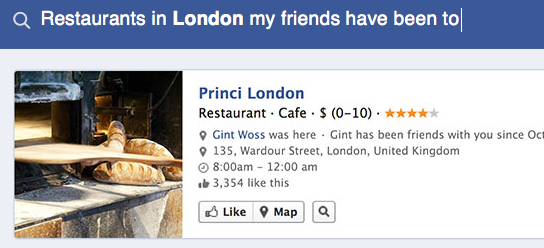 I’ve been using Facebook’s much-vaunted graph search for about a month now, having been on the list for early users. The feature was launched with much fanfare by Facebook in January at a press conference that proved to be distinctly underwhelming. Expectations were high that the company would announce a Facebook phone (The fPhone?) — a blue device capable of automatically recording all your activities and posting them publicly (privacy settings would be permanently disabled). But instead those watching found that the company was rolling out … a better search. Evidence of disappointment was the company’s stock price which had been rising but reversed course halfway through the press conference.
I’ve been using Facebook’s much-vaunted graph search for about a month now, having been on the list for early users. The feature was launched with much fanfare by Facebook in January at a press conference that proved to be distinctly underwhelming. Expectations were high that the company would announce a Facebook phone (The fPhone?) — a blue device capable of automatically recording all your activities and posting them publicly (privacy settings would be permanently disabled). But instead those watching found that the company was rolling out … a better search. Evidence of disappointment was the company’s stock price which had been rising but reversed course halfway through the press conference.
Graph search supposedly makes it easier to find people in your network and discover potential connections. Filters such as “place type,” “liked by,” and “visited by friends” make locating things faster. The feature can serve recruiters by allowing for better search of people’s profiles. It appears to be reasonably effective. As an example I typed in “People that are Java Developers and live in Minnesota” and it turned up 38 names. That’s a small number so I tried variations such as “People that like Java and live in Minnesota” — which produced a much larger number, but many of these were coffee aficionados. Putting in more complex queries, such as adding another skill, produced no results. Switching to finding .Net developers produced only 18 names and trying “People that like .Net and live in Minnesota” turned up three names of people who like to fish.
Seek and Ye Shall Find
Graph Search only searches data in profiles, so it’s limited to what people write about themselves. Facebook profiles are rather thin, especially when compared to LinkedIn. So the potential for using Facebook as a recruiting tool remains small, at least for now. But that’s because most recruiters use social networks like job boards — they search for candidates and then contact them with solicitations for jobs. There’s nothing particularly social about how LinkedIn is used — it’s good for lead generation and not much else.
The “much else” is where Facebook (or some other social network) can make this interesting. The average user spends almost seven hours per month on the site, compared to about seventeen minutes on LinkedIn. But growth in time spent on the site has slowed dramatically and the average number of friends people have has barely budged — now at 262, a change of just 6% over the past year. The risk for Facebook is that the site becomes less and less interesting and people start to move away. By making it easier to find others, Facebook can keep members more engaged and active on the site. The appeal of a social network is all about engagement. Lose that and it’s just a collection of profiles of people who have little to share — like LinkedIn.
Interests vs. Skills
At any given time the vast majority of people are not looking for a job, so getting them to consider a job requires building engagement. But either of the two dominant social networks — Facebook and LinkedIn — offer only a partial solution. One can learn a lot about a person’s skills on one, and interests on the other. What’s needed is something that combines both. Some niche social networks that focus on specific disciplines are starting to emerge to fill the gap — Github being an example of one for software developers. Github may seem like an odd choice but note that the key requirement for being a social network is being a place where people are “social” — they engage in conversations and share. This is why LinkedIn barely makes the grade.
Graph search still needs some work, but it’s a first step in the direction of combining data on interests and skills. Ideally something that can combine data from sites like LinkedIn or specialty networks like Github with data from Facebook would allow recruiters to get the most comprehensive picture of prospective candidates, but that’s a ways off. It requires having a big data infrastructure and cooperation from the social networks, whose business model may be threatened by any such enterprise.